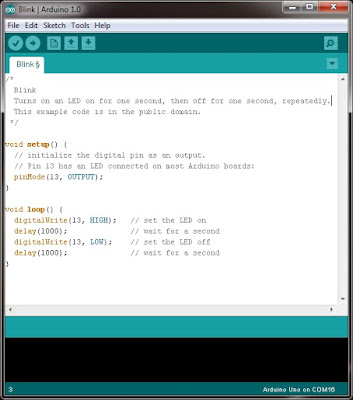Serial Communication
The Arduino board can communicate at various baud (“baud rates”). A baud is a measure of how many times the hardware can send 0s and 1s in a second. The baud rate must be set properly for the board to convert incoming and outgoing information to useful data. If your receiver is expecting to communicate at a baud rate of 2400, but your transmitter is transmitting at a different rate (for example 9600), the data you get will not make sense. To set the baud rate, use the following code:void setup(){
Serial.begin(9600);
}
9600 is a good baud rate to start with. Other standard
baud rates available on most Arduino modules include: 300, 1200, 2400,
4800, 9600, 14400, 19200, 28800, 38400, 57600, or 115200 and you are
free to specify other baud rates. To output a value in the Arduino
window, consider the following programvoid setup()
(
Serial.begin(9600);
}
void loop()
{
Serial.println("hello robotics ");
}
Verify the program by pressing the “verify” button
(looks like a “play” button in order version or a check sign in Arduino
1.0); you should not get any errors at the bottom of the screen. If you
get errors, check that only the two numbers in the code are black, the
rest of the text should have been automatically recognized and assigned a
color. If part of the text is black, check the syntax (often
copy/pasting text from another program can include unwanted formatting)
and capitalization.
Next, upload the sketch to the board using the “Upload
to I/O Board” button (arrow pointing right). Wait until the sketch has
finished uploading. You will not see anything unless you then select the
“Serial Monitor” button (rectangle with a circle that looks like a TV
in the old software, or what looks like a magnifying glass in the new
software). When you select the serial monitor, make sure the baud rate
selected is the same as in your program. If you want to save all your
programs, we suggest creating a new folder called “reference” and save
this program as Hello World.
Blink LED Program
Connect the board to the computer if it is not already
connected. In the Arduino software go to File -> Examples ->
Basics -> Blink LED. The code will automatically load in the window,
ready to be transferred to the Arduino. Ensure you have the right board
chosen in Tools -> Board, and have the right COM port as well under
Tools -> Serial Port. If you are not sure which COM port is connected
to the Arduino, (on a Windows machine) go to Device Manager under COM
& Ports.
Press the “Upload” button and wait until the program
says “Done Uploading”. You should see the LED next to pin 13 start to
blink. Note that there is already a green LED connected to most boards –
you don’t necessarily need a separate LED.
CODE :-
UNDERSTANDING THE CODE:-
pinMode(13, OUTPUT);
This
sets pin 13 as an output pin. The opposite, being INPUT, would have the
pin wait to read a 5V signal. Note that the ‘M’ is capitalized. A lower
case ‘m’ would cause the word “pinmode” to not be recognized.
digitalWrite(13, HIGH); and digitalWrite(13, LOW);
The
line digitalWrite(pin, HIGH); puts a specified pin high to +5V. In this
case we chose pin 13 since on the Uno, the LED is connected to pin 13.
Replacing HIGH with LOW, the pin is set to 0V. You can attach your own
LED using a digital output and the GND pin. Note that the ‘W’ is
capitalized.
delay(1000);
The
delay(1000); line causes the program to wait for 1000 milliseconds
before proceeding (where 1000 is just a convenient example to get a 1
second delay). Note that during a delay, the microcontroller simply
waits and does not execute any additional lines of code.
FEEL FREE TO COMMENT BELOW IF U HAVE ANY DOUBTS OR PROBLEMSS

No comments:
Post a Comment